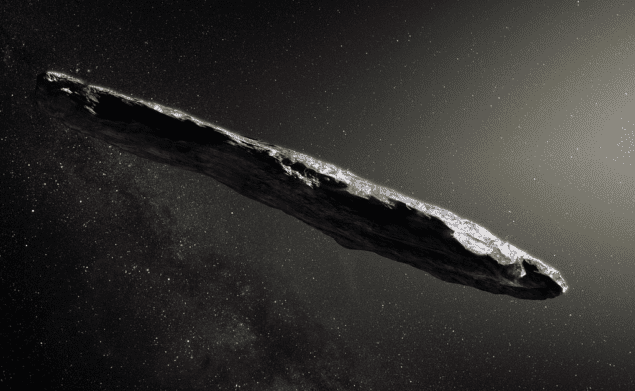
Interstellar objects like the recently-discovered ’Oumuamua could act as the seeds from which planets grow around young stars. That is the conclusion of Susanne Pfalzner of the Jülich Supercomputing Centre in Germany, and Michele Bannister of Queen’s University Belfast – who have modelled how these exotic objects could give the planet-formation process a jump start.
Theories of planet formation describe how dust in discs around nascent stars accretes into ever larger clumps, eventually merging to become protoplanets. These models suggest that this process will take many millions of years and they do not provide clear reasons why collisions between clumps do not bring the process to a halt well before protoplanets form. As a result, these theories are at odds with observations of giant planets around stars that are just a million years old – leaving astronomers asking how did these planets grow so fast?
Pfalzner and Bannister’s answer is that various barriers to speedy planet growth could be bypassed if planet-forming discs were seeded by ’Oumuamua-sized objects. Their idea seems reasonable because such objects should be extremely common. Based upon the presence of ’Oumuamua in the solar system, and the constraints placed upon the number of similar objects by limited sky surveys, scientists estimate that there could be as many as 1015 – a thousand trillion – ’Oumuamua-sized objects in every cubic parsec of space (one parsec is 3.26 light-years). Since the molecular clouds from which stars and planets form are many light years across, they should therefore be teeming with ’Oumuamua-like objects.
Cosmic dandelions
Astronomers believe that interstellar objects can be created in several different ways. They could be left-over building blocks of planets shed early in a planetary system’s life, for example. Or they could be bodies on the edge of planetary systems that disperse when their host stars die. Bannister likens them to dandelion seeds, drifting away to give birth to new planets elsewhere.
“We know that as planetary systems form and evolve, they scatter trillions upon trillions of objects into the galaxy, so this is very much just a feedback effect,” she tells Physics World.
Many of the ’Oumuamua-type objects within the molecular clouds will be consumed when they fall into young stars. However, tens of millions of objects should survive, embedded within the planet-forming discs. Their gravity would draw dust and smaller pebble-sized clumps onto them, allowing them to grow. “This would speed things up considerably,” says Pfalzner, creating fully-formed planets that are just a million years old.
Revolutionary thinking
The new model, if correct, could revolutionize our thinking about how planets, including those in the solar system, formed.
“I think their hypothesis is plausible,” says Jane Greaves, a planet-formation expert at the University of Cardiff. She points out that it avoids one of the main sticking points of planet formation, in that as small clumps of dust collide at high speed they tend to fragment rather than merge, but when these small particles hit a much larger body, they embed themselves into the target, allowing it to gradually grow in mass.

‘Oumuamua: visitor from another star
“The ’Oumuamua seeds would provide a very useful source of these targets,” she says, although she cautions that the subsequent collisions between the ’Oumuamua-sized bodies to build even larger planetesimals require further study.
A paper describing the process has been accepted for publication in The Astrophysical Journal Letters. It raises the intriguing notion that planet formation may not have been as efficient in the past. The first planets in the universe would not have had ’Oumuamua-like seeds available, and so they may have formed slowly. As more planetary systems formed, and their stars died, more objects like ’Oumuamua would be drifting into interstellar space, increasing the chances that they could become seeds for new planets. “Space is filling up with this stuff over time,” says Pfalzner.
“Planet formation was potentially a little bit less efficient in the past,” says Bannister. However, she describes how future work, involving building numerical simulations to show how this planet-forming efficiency grows over time, will “be fun to work through, building a galaxy-wide model incorporating interstellar objects, their velocity distributions, their density and planetary formation efficiency as a result”.



